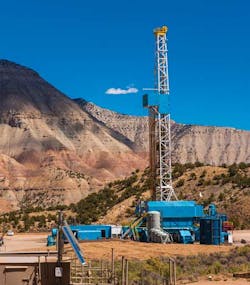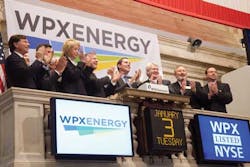Financial discipline and efficiencies set WPX Energy apart from its peers
AN INTERVIEW WITH RALPH A. HILL, PRESIDENT AND CEO OF WPX ENERGY
OIL & GAS FINANCIAL JOURNAL: In January 2012, WPX Energy successfully spun off from the Tulsa-based Williams Companies to create an upstream company focused on large-scale growth assets. It's been more than a year now. How are things going?
RALPH HILL: We're energized and confident in our strength to create value for our shareholders. We're already the tenth-largest gas producer in the nation, and we intend to be an even larger player in the E&P space. We were built for this moment. In the right commodity price environment, we can grow all of our product lines – natural gas, oil, and NGL – by double digits for years to come with what we already own. In doing so, we could effectively double the size of our company in about 5 years. We're firm believers in a strong balance sheet and financial discipline, so when natural gas prices fell last year we rapidly adjusted our capital spending plans by dropping rigs and kept pursuing new efficiencies in our operations. Through that, we significantly reduced our Bakken drilling times and our Marcellus completion costs. This relentless drive to create efficiencies is one of the things that sets us apart. We also have a very talented management team with more than 200 years of combined experience.
OGFJ: WPX's ability to grow production is impressive. Shortly before your spinoff, WPX engaged in two significant acquisitions – one in the Bakken and one in the Marcellus. In 2012, you grew production in those areas by 98% and 320%, respectively. What prompted these acquisitions, and how is your company able to deploy such a successful development program?
HILL: This is all about evolving our business and resolving to never settle for status quo. We have a plan to create value, and we're going to keep executing, starting with our rate-of-return capital allocation strategy. We've been shaping this company for three decades starting with our early days in the San Juan basin around 1983. In 2001, we acquired our position in the Piceance basin. We recognized we had a world-class asset so we embarked on building an efficiency model to support large-scale development. We dramatically grew production by utilizing new-build, next-generation, high efficiency rigs. We called those "fit-for-purpose" rigs and we still employ that strategy in all of our basins. By 2006, we won a global industry award for growing our production eight-fold. We followed that achievement with establishing our presence in the Marcellus and the Bakken, where we have almost 200,000 net acres combined. We're in the sweet spots of both plays, and we really like the geographic and product diversity they add to our portfolio. We will continue to use our experience to evolve WPX, such as high-grading our portfolio. Last year we divested our Barnett holdings. Now we're looking to monetize our holdings in the Powder River basin.
OGFJ: The Bakken has been a focal point for a lot of investors. Following the acquisition, what steps did you take to integrate the position into your asset portfolio? How are your cost savings initiatives progressing in the play?
HILL: We take a lot of pride in our efficiency model. We crafted it over a number of years in the Piceance where we've improved average spud-to-spud drilling times from 30 days down to less than 10. Our record time in the Piceance is actually 3.7 days. We also implemented simultaneous operations there, along with remote frac pads and water recycling. We believe we were the first to do simultaneous operations onshore. We can produce, drill, and complete wells all at the same time on the same pad. The goal is to build economies of scale across an asset area.
We're taking the same approach with our Bakken assets. It's a relatively new asset for us, acquired in late 2010. Today we have about 80 million barrels of proved reserves in the Bakken. Our first priority was to hold our acreage by production. We accomplished that, securing 84,000 acres. This caused our early costs to be higher than we prefer as we moved rigs around to hold production. With those days behind us and more than 85% of our locations left to drill, now we can look at the bigger picture and build the kind of efficiencies that will give us a very competitive cost structure versus our peers, even with our use of ceramic proppant, which adds about $1 million per well.
WPX's discovery well in the Niobrara Shale produced more than 1 Bcf of natural gas in just over 100 days. The company plans to drill four more horizontal Niobrara wells in 2013.Photo by Jim Blecha. Courtesy of WPX.
One of the things we're doing is shifting to multi-well development pads. Our recent Bakken costs are down 10% to 20% on long lateral wells through fewer drilling days and completion efficiencies such as zipper fracs. Our best drilling time so far is 25 days, down from around 40 when we first hit the ground. We've completely turned over our rig fleet and transitioned to fit-for-purpose rigs. With these rigs, we'll be able to do more with less from an efficiency standpoint. For example, we're going to drill about the same number of wells in 2013 as we did in 2012, but with fewer rigs. It's an efficiency gain of about 30%. Last year we also recovered 372 feet of continuous core in the Bakken and Three Forks, along with portions of the Lodgepole and Birdbear formations. We're using that data to target the most geologically productive zones in the Middle Bakken and Three Forks and to understand if there are other productive zones on our acreage which contain hidden upside.
WPX is growing oil production. The company grew its Bakken Shale production by 98% in 2012, with plans to run four rigs in the basin this year. WPX has 84,000 net acres in the Bakken.Photo by Jim Blecha. Courtesy of WPX.
OGFJ: The Marcellus shale is the most successful natural gas play in the US today. Competition for acreage is fierce. How were you able to access the play and acquire core acreage? What steps has WPX taken to assure adequate takeaway capacity for the growth expected in the play?
HILL: Our exploration team studied the Marcellus for quite some time. We believed in the area from a technical perspective and knew that we could transfer our knowledge from other unconventional gas plays, particularly our Piceance efficiency model. We haven't been disappointed. We have 114,000 net acres in Pennsylvania that have mostly come through two key transactions. We did the first deal in summer 2009. It was a drill-to-earn arrangement across 44,000 acres. That one put us in Westmoreland County. We did the second deal a year later. The centerpiece of that was more than 40,000 acres in Susquehanna County. Between the two transactions, we acquired the land for around $7,000 per acre. We've drilled about 100 wells so far and are planning to spend $125 million in the area this year after growing our production by 300 percent last year. We have firm transportation contracted on Millennium Pipeline to move our production to downstream markets. Marcellus intra-region infrastructure continues to lag production in many areas, and we are fortunate to have structured a transportation agreement that provides the flexibility needed to meet our future growth expectations.
OGFJ: You recently reported some news out of the Niobrara. Put this in perspective for our readers – does this have the potential to be a game changer for WPX?
HILL: It's early, but we believe so. The Niobrara can be a huge resource for WPX that's right underneath our Piceance acreage, where we've mainly drilled in the tight sands of the Williams Fork formation. The Williams Fork is shallower, about 6,000 to 9,000 feet deep. The Niobrara is about 10,000 to 13,000 feet deep.
In late 2011, we drilled a vertical test well in the Niobrara. We liked the data, so we decided to do a horizontal well in 2012. The well hit an initial high of 16 million cubic feet per day despite being substantially choked back. Over its first 90 days, it registered about 10 million cubic feet per day. A few days later, it hit 1 billion cubic feet in cumulative production. At this rate, it will produce in its first four to five months what a typical Williams Fork well produces in 25 to 30 years.
Members of WPX's management team celebrated the company's start as an independent company by ringing the opening bell at the New York Stock Exchange on Jan. 3, 2012. Photo by Valerie Caviness. Courtesy of WPX.
We plan to drill four more horizontals in the Niobrara this year to prove up adjacent acreage and test the repeatability of the play. In the long run, we think the Niobrara has the potential to more than double our 18 trillion cubic feet equivalent of 3P reserves. So it has the potential to be a game changer for WPX that makes our portfolio even stronger. We may have Susquehanna or better type wells in the Piceance where we have the benefit of scale, existing facilities, and years of experience.
OGFJ: Despite the sheer size and potential in the Piceance, the play has remained under the radar on most screens. What qualities does the Piceance have that WPX finds attractive?
HILL: Without question, the Piceance is our cornerstone asset. The reason you don't hear a lot about the area is because no one else has the kind of position that we have in the basin. For WPX, the Piceance is a unique, world-class position with a proven track record of attractive returns and a long-term inventory. Just look at the numbers. We're talking about 216,000 net acres, 3 tcf in proved reserves, 12 tcf in 3P reserves, 4,100 wells, 10,000 remaining undrilled locations, about 60% of our total volumes, and a production stream that includes significant NGL value. And this doesn't account for any of the potential upside associated with our recent Niobrara discovery. Quite honestly, the Piceance has been a company-maker for us since we bought these holdings in 2001.
The scope of what we've built has made us Colorado's largest gas producer while our costs average 20% to 30% less than our peers. The difference is our scale, our efficiencies, and the fact that we're in the geologic core of the basin. We have state-of-the-art water management systems. We have favorable long-term liquids processing contracts. We have extensive long-term takeaway capacity. Everything is in place for another ramp up like we did 5 to 7 years ago if prices improve. And our drilling times just keep improving. Our best time is down to less than 4 days, which is a phenomenal feat and a credit to our asset team. They have continually implemented new ideas that lower costs and help us tap more locations. Last year we won an innovation award for working with one of our drilling vendors to modify a rig to fit into tight, narrow canyons. It's called a spilt rig, and the setup requires about half the acreage of a typical pad.
OGFJ: Let's talk capital allocation for 2013. Where is the lion's share of capital going?
HILL: Last year, through our capital spending, we increased oil production by 40%, NGL production by 3%, and natural gas volumes by 2%. This year we're looking to spend $1 billion to $1.2 billion. One of our primary goals is to increase our Bakken Shale oil volumes by 25% to 30%. About 75% to 80% of CAPEX is devoted to the Bakken and to more liquids-rich production in the Piceance, and to taking a more aggressive posture with regard to exploration.
In our days as a subsidiary at Williams, we typically worked with a zero budget for exploration because the preference of the parent company was to let other players de-risk new resources. But as a pure-play E&P company, we're going to test plays earlier and acquire acreage through grassroots leasing, with the obvious goal of establishing a lower cost of entry. This year we've included $95 million for such measures, including leasing in new areas and drilling 8 exploratory oil wells where we bought leases last year.
OGFJ: Debt, hedging, and finances – what's your goal? What is WPX's appetite in these areas?
HILL: At WPX, we are absolutely determined to run a disciplined ship that has financial flexibility and a strong balance sheet. Our management team knows that it's imperative to prepare for a rainy day. About a decade ago when I was at Williams, we were faced with a situation where we had to sell off a billion dollars of high quality assets in 72 hours to help the parent company survive. The experience marked me, and a lot of folks. We're going to have a strong balance sheet and protect it at WPX, like we did last year when we faced the headwinds of the lowest natural gas price environment our industry has seen in 13 years. We navigated through that, reduced our CAPEX, worked to lower costs and looked for new efficiencies in our drilling program, which we're beginning to realize by consolidating our drilling organization into one team instead of having separate drilling functions in each of our basins. On our finances, we will continue to maintain a level of liquidity that helps the company thrive regardless of whatever challenge we face. It's all about liquidity and having ample reserves to meet our obligations and capitalize on opportunities. In terms of our revenue streams, typically we like to hedge about half of our expected volumes.
OGFJ: We've heard from analysts and money managers that WPX is positioned to be the first and fastest company to rapidly grow natural gas production given an increase in natural gas prices. Your thoughts?
HILL: At our core, we realize that we have one of the best natural gas portfolios in the business. This is something that distinguishes WPX. We have 18 tcfe of 3P reserves, not including any reserves for our Piceance Niobrara discovery which could more than double our 3P reserves. We can grow gas in multiple areas, including the Marcellus, the Piceance, and the San Juan, where we also have Mancos potential. But it all starts with the Piceance, where we have 10,000 remaining 3P locations. When prices were more attractive, we ran more than 25 rigs in the Piceance. In this environment, we're maintaining a disciplined approach with 5 rigs. As prices recover, we are poised for rapid growth. We have the permit inventory, the infrastructure, processing contracts, take-away capacity, and a highly experienced team in place. Our people – across our basins – are eager for the day when it's financially attractive to hit the pedal to grow gas volumes.
OGFJ: WPX has numerous operational catalysts lined up for 2013. What should our readers be on the lookout for?
HILL: At WPX, we're just getting started coming off the heels of our spinoff. Our 2013 goals are to (1) grow oil production (2) maintain disciplined natural gas development but remain poised to be the first and fastest to grow gas production (3) continually improve costs and (4) pursue our new exploration opportunities. We're probably going to make more headlines with our oil and new opportunities until natural gas prices substantially turn the corner. Our Bakken asset continues to improve and we're forecasting annual production growth there of 25% to 30%. We expect overall natural gas volumes to decline somewhat vs. 2012, even with our Marcellus gas volumes growing as infrastructure capacity and reliability grow. If gas prices continue to improve, we could arrest a gas production decline by picking up our gas drilling activity. And we're very excited about drilling 4 horizontals in the Niobrara this year and 8 exploratory oil wells in new areas. More on that later.
OGFJ: Thanks for talking to us.




